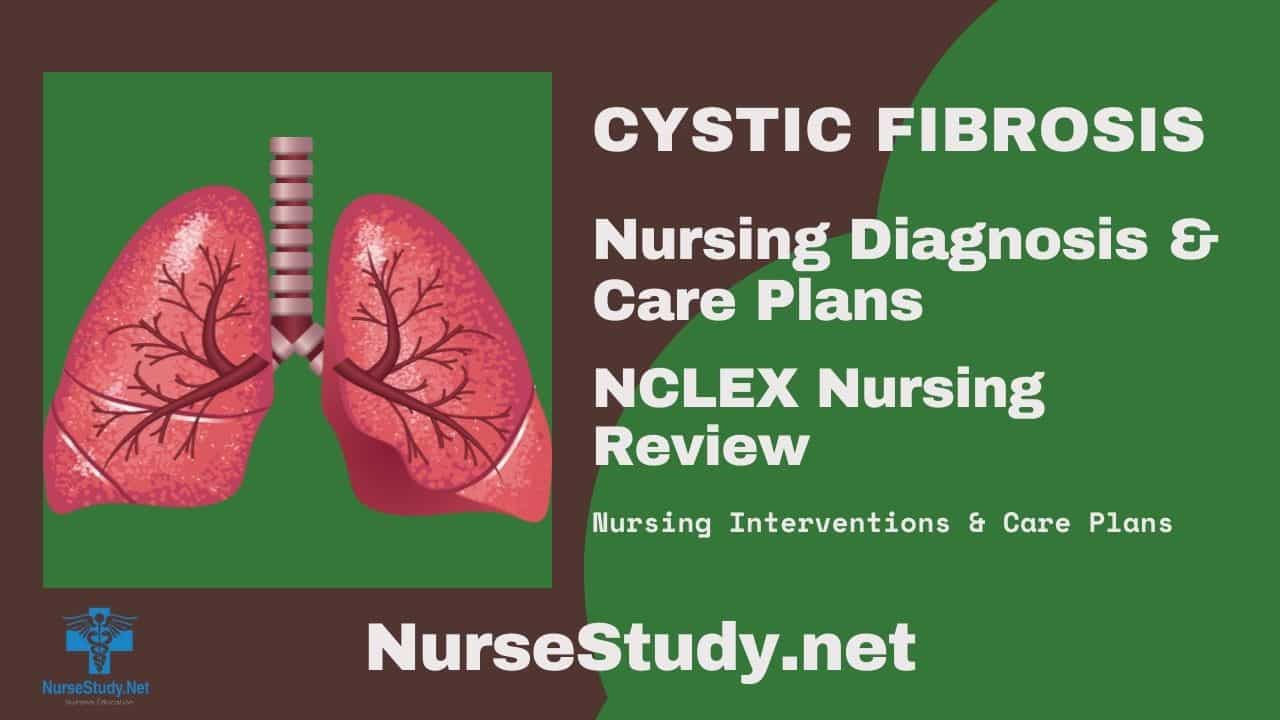Cystic Fibrosis (CF) is a complex genetic disorder that primarily affects the respiratory and digestive systems. As a progressive condition, it requires comprehensive nursing care and ongoing management. This article provides detailed nursing diagnoses, interventions, and care plans for patients with cystic fibrosis.
Understanding Cystic Fibrosis
Cystic fibrosis results from mutations in the CFTR gene, leading to thick, sticky mucus production that affects multiple organ systems. This genetic disorder primarily impacts:
- Respiratory system
- Digestive system
- Reproductive system
- Sweat glands
Common Clinical Manifestations
Nurses should be familiar with these key symptoms:
Respiratory Symptoms:
- Persistent coughing with thick mucus
- Recurring chest infections
- Wheezing and shortness of breath
- Nasal polyps
Digestive Symptoms:
- Malnutrition
- Greasy, bulky stools
- Poor weight gain
- Intestinal blockage
Other Symptoms:
- Salty-tasting skin
- Delayed growth
- Infertility in males
- Clubbing of fingers and toes
Key Nursing Assessments
Physical Assessment
Respiratory Assessment:
- Breath sounds
- Respiratory rate and pattern
- Use of accessory muscles
- Presence of cyanosis
Nutritional Assessment:
- Weight and height
- BMI calculation
- Dietary intake
- Signs of malnutrition
Gastrointestinal Assessment:
- Bowel patterns
- Stool characteristics
- Abdominal distension
- Signs of obstruction
Diagnostic Tests
Monitor and assist with:
- Sweat chloride test
- Pulmonary function tests
- Chest X-rays
- Sputum cultures
- Genetic testing
Top 5 Nursing Care Plans for Cystic Fibrosis
1. Ineffective Breathing Pattern
Nursing Diagnosis Statement:
Ineffective breathing pattern related to increased mucus production and airway obstruction as evidenced by dyspnea, abnormal breathing patterns, and use of accessory muscles.
Related Factors/Causes:
- Thick mucus secretions
- Bronchial obstruction
- Inflammation of airways
- Respiratory muscle fatigue
Nursing Interventions and Rationales:
- Monitor respiratory rate, depth, and pattern
Rationale: Enables early detection of respiratory deterioration - Perform chest physiotherapy
Rationale: Helps mobilize secretions and improve airway clearance - Teach pursed-lip breathing
Rationale: Improves ventilation and reduces work of breathing - Position patient for optimal breathing
Rationale: Promotes lung expansion and easier breathing
Desired Outcomes:
- The patient maintains an effective breathing pattern
- Demonstrates improved respiratory function
- Shows decreased use of accessory muscles
2. Imbalanced Nutrition: Less Than Body Requirements
Nursing Diagnosis Statement:
Imbalanced nutrition: less than body requirements related to pancreatic insufficiency as evidenced by weight loss and failure to thrive.
Related Factors/Causes:
- Malabsorption
- Increased metabolic demands
- Pancreatic enzyme deficiency
- Poor appetite
Nursing Interventions and Rationales:
- Monitor weight and nutritional intake
Rationale: Tracks nutritional status and effectiveness of interventions - Administer pancreatic enzymes
Rationale: Improves nutrient absorption - Provide a high-calorie, high-protein diet
Rationale: Meets increased metabolic demands - Schedule small, frequent meals
Rationale: Maximizes nutrient intake and absorption
Desired Outcomes:
- Patient maintains appropriate weight for height/age
- Demonstrates improved nutritional status
- Shows normal growth patterns
3. Risk for Infection
Nursing Diagnosis Statement:
Risk for infection related to thick mucus accumulation and compromised respiratory defense mechanisms.
Related Factors/Causes:
- Mucus stasis
- Compromised immune system
- Frequent hospitalizations
- Invasive procedures
Nursing Interventions and Rationales:
- Implement infection control measures
Rationale: Reduces risk of cross-contamination - Monitor for signs of infection
Rationale: Enables early detection and treatment - Promote immunization compliance
Rationale: Protects against preventable infections - Teach proper hand hygiene
Rationale: Reduces transmission of pathogens
Desired Outcomes:
- The patient remains free from infection
- Demonstrates understanding of infection prevention
- Maintains effective airway clearance
4. Activity Intolerance
Nursing Diagnosis Statement:
Activity intolerance related to impaired gas exchange and increased work of breathing as evidenced by fatigue and dyspnea with activity.
Related Factors/Causes:
- Decreased oxygen delivery
- Increased energy expenditure
- Respiratory muscle weakness
- Poor nutritional status
Nursing Interventions and Rationales:
- Assess activity tolerance
Rationale: Determines appropriate activity level - Plan activities with rest periods
Rationale: Prevents excessive fatigue - Encourage progressive exercise
Rationale: Builds endurance and strength - Monitor oxygen saturation during activity
Rationale: Ensures adequate oxygenation
Desired Outcomes:
- The patient demonstrates improved activity tolerance
- Maintains adequate oxygenation during activities
- Participates in daily activities without excessive fatigue
5. Deficient Knowledge
Nursing Diagnosis Statement:
Deficient knowledge related to complex disease processes and management requirements as evidenced by questions about care and verbalization of concerns.
Related Factors/Causes:
- Complex treatment regimen
- New Diagnosis
- Information overload
- Language or cultural barriers
Nursing Interventions and Rationales:
- Assess knowledge level
Rationale: Identifies learning needs - Provide disease education
Rationale: Improves understanding and compliance - Teach medication administration
Rationale: Ensures proper treatment - Demonstrate care techniques
Rationale: Promotes skill development
Desired Outcomes:
- Patient verbalizes understanding of disease process.
- Demonstrates proper care techniques
- Shows improved compliance with treatment
References
- Bell, S. C., et al. (2023). “The Future of Cystic Fibrosis Care: A Global Perspective.” The Lancet Respiratory Medicine, 11(1), 71-84.
- Castellani, C., et al. (2023). “ECFS Best Practice Guidelines: The 2023 Revision.” Journal of Cystic Fibrosis, 22(4), 359-398.
- Davies, J. C., et al. (2023). “Cystic Fibrosis.” Nature Reviews Disease Primers, 9(1), 1-24.
- Ratjen, F., et al. (2023). “Cystic Fibrosis: Current Understanding and Future Perspectives.” Cell, 186(1), 63-79.
- Saiman, L., et al. (2023). “Infection Prevention and Control Guidelines for Cystic Fibrosis.” Infection Control & Hospital Epidemiology, 44(2), 207-216.
- Withers, A. L. (2023). “Management of Cystic Fibrosis: A Nursing Perspective.” Journal of Pediatric Nursing, 58, 42-49.
